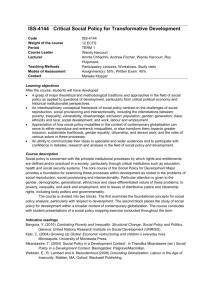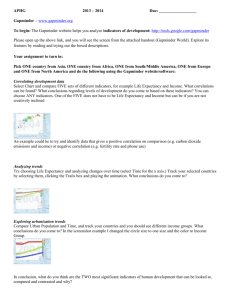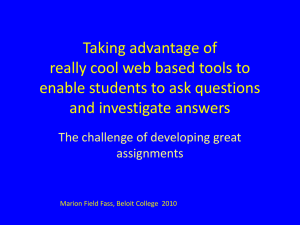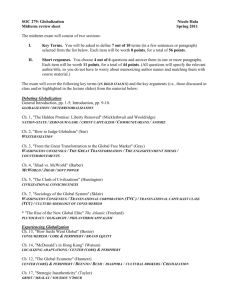Writeup by Mike Patterson
advertisement
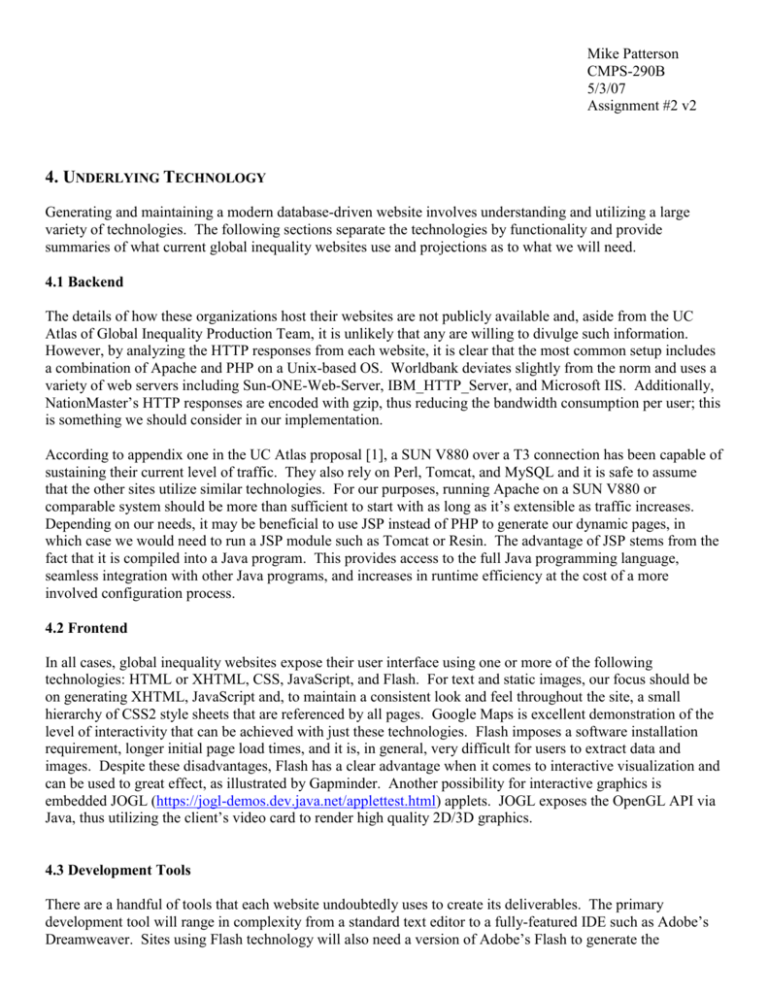
Mike Patterson CMPS-290B 5/3/07 Assignment #2 v2 4. UNDERLYING TECHNOLOGY Generating and maintaining a modern database-driven website involves understanding and utilizing a large variety of technologies. The following sections separate the technologies by functionality and provide summaries of what current global inequality websites use and projections as to what we will need. 4.1 Backend The details of how these organizations host their websites are not publicly available and, aside from the UC Atlas of Global Inequality Production Team, it is unlikely that any are willing to divulge such information. However, by analyzing the HTTP responses from each website, it is clear that the most common setup includes a combination of Apache and PHP on a Unix-based OS. Worldbank deviates slightly from the norm and uses a variety of web servers including Sun-ONE-Web-Server, IBM_HTTP_Server, and Microsoft IIS. Additionally, NationMaster’s HTTP responses are encoded with gzip, thus reducing the bandwidth consumption per user; this is something we should consider in our implementation. According to appendix one in the UC Atlas proposal [1], a SUN V880 over a T3 connection has been capable of sustaining their current level of traffic. They also rely on Perl, Tomcat, and MySQL and it is safe to assume that the other sites utilize similar technologies. For our purposes, running Apache on a SUN V880 or comparable system should be more than sufficient to start with as long as it’s extensible as traffic increases. Depending on our needs, it may be beneficial to use JSP instead of PHP to generate our dynamic pages, in which case we would need to run a JSP module such as Tomcat or Resin. The advantage of JSP stems from the fact that it is compiled into a Java program. This provides access to the full Java programming language, seamless integration with other Java programs, and increases in runtime efficiency at the cost of a more involved configuration process. 4.2 Frontend In all cases, global inequality websites expose their user interface using one or more of the following technologies: HTML or XHTML, CSS, JavaScript, and Flash. For text and static images, our focus should be on generating XHTML, JavaScript and, to maintain a consistent look and feel throughout the site, a small hierarchy of CSS2 style sheets that are referenced by all pages. Google Maps is excellent demonstration of the level of interactivity that can be achieved with just these technologies. Flash imposes a software installation requirement, longer initial page load times, and it is, in general, very difficult for users to extract data and images. Despite these disadvantages, Flash has a clear advantage when it comes to interactive visualization and can be used to great effect, as illustrated by Gapminder. Another possibility for interactive graphics is embedded JOGL (https://jogl-demos.dev.java.net/applettest.html) applets. JOGL exposes the OpenGL API via Java, thus utilizing the client’s video card to render high quality 2D/3D graphics. 4.3 Development Tools There are a handful of tools that each website undoubtedly uses to create its deliverables. The primary development tool will range in complexity from a standard text editor to a fully-featured IDE such as Adobe’s Dreamweaver. Sites using Flash technology will also need a version of Adobe’s Flash to generate the executable. For vector graphic manipulation, sites will likely be using either Adobe Illustrator or the free, opensource Inkscape. Similarly for raster graphic manipulation, sites will likely be using either Adobe Photoshop or the free, open-source GIMP. UC Atlas additionally uses the Arc products to generate their maps and MyAdmin for MySQL management. We will need a version of each of these tools during the development of our new site. Dataset Sources UC Atlas (http://ucatlas.ucsc.edu/data.html) Database Graphs Maps Tables X Major Sources X X The World Bank's World Development Indicators 2002 CD-ROM X X X World Health Organization (WHO) (http://www3.who.int/whosis/menu.cfm) X X X United Nations Human Development Report (http://hrd.undp.org/) Other Online Datasets (http://ucatlas.ucsc.edu/metadata/metadata.html) Gapminder (http://www.gapminder.org/links/data/) GeoHive - the World in Regions (http://www.gapminder.org/links/data/geohive---the-world-in-regions.html) Nationmaster (http://www.gapminder.org/links/data/nationmaster.html) OECD Data (http://www.gapminder.org/links/data/oecd-data.html) Social Watch (http://www.gapminder.org/links/data/social-watch.html) Statistics Sweden (Satistiska CentralbyrÃ¥n) (http://www.gapminder.org/links/data/statistics-sweden-satistiskacentralbyra%C2%A5n.html) Sustainable World (http://www.gapminder.org/links/data/sustainable-world.html) The World Factbook (http://www.gapminder.org/links/data/the-world-factbook.html) United Nations Common Database (UNSCB) (http://www.gapminder.org/links/data/united-nations-commondatabase-unscb.html) UNESCO Institute for Statistics (http://www.gapminder.org/links/data/unesco-institute-for-statistics.html) World Bank: World Development Indicators (http://www.gapminder.org/links/data/world-bank-worlddevelopment-indicators.html) WorldHistory.com (http://www.gapminder.org/links/data/worldhistory.com.html) NationMaster (http://www.nationmaster.com/statistics/sources) WorldMapper (http://www.sasi.group.shef.ac.uk/worldmapper/credits.html) References Appadurai, A. (1996). Modernity at large: cultural dimensions of globalization. Minneapolis, Minn., University of Minnesota Press. Bardhan, P (n.d.). Globalization, Inequality and Poverty: An Overview. Downloaded from globetrotter.berkeley.edu/macarthur/inequality/papers/BardhanGlobalOverview.pdf Barratt, Christopher and Joan Esteban (2005) Social Groups and Economic Inequality. Journal of Economic Inequality, 3, 187-191. Braveman, P. (2002a). "Measuring Health Equity Within Countries: The Challenge of Limited Information." MSJAMA 288(October 2, 2002): 1650 Braveman, P. and Eleuthor Tarimo. 2002. “Social inequalities in health within countries: not only an issue for affluent nations.” Social Science and Medicine 54:1621-1635 Firebaugh, G. and B. Goesling (2004). "Accounting for the Recent Decline in Global Income Inequality." American Journal of Sociology, Volume 110 (Number 2 (September 2004)): 283–312. Goesling, B. and Glenn Firebaugh. 2004. “The Trend in International Health Inequality.” Population and Development Review 30(1):131-146. Harris, R.L., and Melinda J. Seid. 2004. “Globalization and Health in the New Millennium.” Perspectives on Global Development and Technology 3:1-2. Kanbur, R. and L. Squire (2001). The evolution of thinking about poverty. Frontiers of Development Economics: the future in perspective. G. Meier and J. Stiglitz, World Bank and Oxford University Press. Martin, Philip (1992). “The Migration Issue.” Migration World Magazine v20, n5, Nov – Dec 1992 p10(6). McMichael, A.J. and Robert Beaglehole. 2000. “The Changing Global Context of Public Health.” The Lancet 2000 356:49599. Retrieved February 2, 2006 (http://www.thelancet.com/journals/lancet/article/PIIS0140673600025642/fulltext) Milanovic, B. (1999). "True world income distribution, 1988 and 1993: First calculation based on household surveys alone", World Bank. Milanovic, B (2005) Worlds Apart: Measuring International and Global Inequality. Princeton: Princeton University Press. Ravallion, M. 2004 “Competing concepts of inequality in the World Bank. globalization debate”, PRWP 3243, Saxenian, AnnaLee (1999) Silicon Valley’s New Immigrant Entrepreneurs. Public Policy Institute of California. Sala-i-Martin, X. (2001). The Disturbing "Rise" of Global Income Inequality. http://www.columbia.edu/~xs23/papers/GlobalIncomeInequality.htm Secor, Laura (2003) 'Mind the gap: the debate over global inequality heats up'. Boston Globe, January 5th, pD1, section: Ideas. Sen, A. (2002). " How to judge globalism ." American Prospect Sen, A. (1993). "The Economics of Life and Death." Scientific American(May): 40-47. Sutcliffe, B. 2004 'World Inequality and Globalization', Oxford 20, No. 1. Review of Economic Policy, Vol UC Atlas of Global Inequality Production Team. A proposal to the University of California Press. May 2006. Wade, R. (2001). "Winners and Losers." The Economist (4/26). Wade, R. (2004a). "Is Globalization Reducing Poverty and Inequality?" World Development 32(4): 567589. Wade, R. (2004b) "Inequality and Globalization: A Comment on Firebaugh and Goesling". UCSC CGIRS Paper CGIRS-2004-10. http://repositories.cdlib.org/cgirs/CGIRS-2004-10




